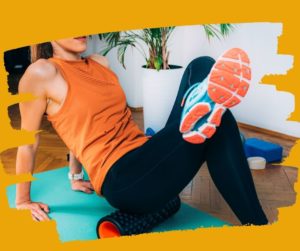What is DOMS and does stretching help?
If you’ve recently started a new regime or upped your existing one and have been getting sore muscles after your workout – it could be DOMS.
This is a conversation I have with new clients who are unaccustomed to exercise and in this blog I talk about what is DOMS, what helps and what doesn’t.
Delayed onset muscle soreness (DOMS) is the pain and stiffness felt in muscles several hours to days after unaccustomed or strenuous exercise.
Why Do I Get DOMS
Pretty much any high-intensity exercise can cause DOMS, but one kind in particular, known as eccentric exercise, often triggers it. Eccentric exercises cause you to tense a muscle at the same time you lengthen it.
For example, a controlled, downward motion as you straighten your forearm after a bicep curl is an eccentric movement.
The soreness is felt most strongly 24 to 72 hours after the exercise.
You won’t feel DOMS during a workout.
Symptoms of DOMS to watch out for may include:
- muscles that feel tender to the touch
- reduced range of motion due to pain and stiffness when moving
- swelling in the affected muscles
- muscle fatigue
- short-term loss of muscle strength
What causes DOMS
DOMS is caused by myofibril tears (muscle strains). The microtrauma results in an inflammatory response with intramuscular fluid and electrolyte shifts. The mechanism of DOMS is associated with increased serum creatine kinase activity, acute inflammation and cellular calcium efflux.
Biochemical markers (such as creatine kinase and lactic dehydrogenase) are found in the blood of DOMS sufferers, which is consistent with disruption of muscle fibres.
The science:
‘Forces associated with muscular contractions, particularly eccentric actions, cause the formation of small micro-tears in both the contractile elements and surface membrane (sarcolemma) of working muscle fibres.
These micro-tears allow calcium to escape from the muscles, disrupting their intracellular balance and causing further injury to the fibres.
Various proteins then interact with the free nerve endings surrounding the damaged fibres, resulting in localized pain and stiffness. Symptoms can be exacerbated by swelling within muscle fibres, which exerts pressure on sensory receptors (nociceptors) and thereby increases the sensation of pain’
Brad Schoenfeld 2010
‘Swelling, altered muscle firing patterns and pain is thought to be the reason why muscle strength, motions and function is impaired in DOMS sufferers.’
Black et al 2008, Cleak et al 1992, MacIntyre et al 2001, Cheung et al 2003, Dutto and Braun 2004, Paschalis 2007
It can be a bit disheartening if you’re trying to improve your fitness and are getting sore muscles. Soreness is neither a good or bad thing: if you’re not sore after training it doesn’t mean you didn’t work hard.
But don’t let DOMS put you off working towards your goals.
How long will it last?
DOMS can last around two to three days, depending on the intensity of the exercise you were doing. It usually comes on within a day or so of the exercise session.
Once your muscles are used to the exercise you shouldn’t get as much soreness. But if you up the intensity or start something new, then you might get it again. This is the normal process of building and strengthening muscles.
Is it DOMS or something else?
It’s important to know the difference between DOMS and pain caused by a strain or injury. DOMS comes on after you’ve exercised. Stop exercise if you have sudden pain during exercise, as this could be an injury that needs to be treated differently.
What Can I do to Ease DOMS
Time is the main treatment for DOMS, but you can take steps to ease the pain and stiffness while you wait for your muscles to repair themselves. The good news is that most cases of DOMS gradually subside and have no lasting effects. Most cases of DOMS will resolve within one to three days.
Keep moving to ease sore, stiff muscles
You might be tempted to rest and avoid all exercise and movement when DOMS strikes, but unless it’s severe, hitting the couch for the day may only worsen pain and stiffness, not ease it.
You may want to avoid any kind of high-intensity cardio or power lifting sessions when sore as that may only worsen and delay your recovery from DOMS. Try gentle yoga or some low- to moderate-intensity walking, cycling, or swimming
Compression garments
These are items of clothing that fit tightly around your affected arm or leg; so you might wear a sleeve for example, if the muscles in your arms are sore. It’s thought that compression increases the blood flow and reduces muscle inflammation, which can reduce the effects of DOMS.
The latest research in the esteemed journal Brukner & Khan’s Clinical Sports Medicine shows wearing compression socks significantly reduces DOMS. Try wearing compression garments as soon as you finish exercise and keep them on for 24 hours.
Epsom Salts
One solution is quick and easy: pour a cup of Epsom salts in a warm bath. Epsom salts are rich in magnesium, a magic mineral that helps widen your blood vessels to boost your recovery, and soak soreness from your muscles.
Quite simply, you it in a hot bath and soak in it.
Epsom Salts to ease DOMS
- Run a hot bath, but not so hot that it’s uncomfortable.
- Add 1-2 cups of Epsom Salts (depending on instructions).
- Mix in the water until dissolved.
- Soak your body for up to 30 minutes.
Foam Rolling
After an intense bout of exercise, foam rolling for 20 minutes has been shown to help with recovering from DOMS and tender muscles.
Foam rolling is thought to alleviate DOMS and improve muscular performance.
Potentially, foam rolling may be an effective therapeutic modality to reduce DOMS while enhancing the recovery of muscular performance.
Gregory E. P. Pearcey, MSc, David J. Bradbury-Squires, MSc,* Jon-Erik Kawamoto, MSc,* Eric J. Drinkwater, PhD,*† David G. Behm, PhD,* and Duane C. Button, PhD (2015)
Eat Right
Your muscles require the right nutrients to recover and at no other time greater than immediately after your workout. Feeding your muscles with fast digesting carbs and protein within 30 minutes of exercise will not only help to take you out of a catabolic state but also aid the recovery process.
Steak with spinach, sweet potato and red peppers is your ultimate muscle-repairing meal. Plenty of muscle-boosting protein from the steak, lots of vitamin E from spinach and sweet potato, plus an energising dose of vitamin C from your red peppers
Following a well-balanced meal-plan at all other times will also help speed up recovery, we will have an article on this coming soon.
What will NOT help DOMS
Passive stretching
Will increase your symptoms which is one of the reasons why you feel stiff.
Deep tissue massage
Should be avoided during the first 24 hours.
Ice pack or ice bath
Some research has suggested that a dip for 10 minutes at six degrees can reduce the symptoms of DOMS, whilst also improving the range of motion after an intense bout of exercise. However, it has also been suggested that although applying ice is although shown to reduce perceived soreness, it doesn’t aid in muscle recovery and may impede it in the long term. Ming Chew (2011) advises against ice, to avoid causing fascial restriction.
Contrast baths/showers
The rationale behind contrast heat and cold is to induce alternating vasodilation/vasoconstriction of the blood vessels at the affected area. Unfortunately, this is a myth and has been observed to actually increase DOMS in a controlled trial.

Rachel Law is a personal fitness trainer based in New Malden, Surrey. Qualifications: ActivIQ Level 3 Personal Training; Burrell Education Pregnancy Exercise Prescription; Burrell Education Advanced Pregnancy Wellness Practitioner; Burrell Education Advanced Post Natal Exercise Prescription; Burrell Education 3rd Age Women Optimal Health and Nutrition; Burrell Education Peri Natal Athlete; Burrell Education Pelvic Flow and Freedom; Olympic Weight Lifting; Premier Global Kettlebells; FIE Level Assessment and Mentoring


